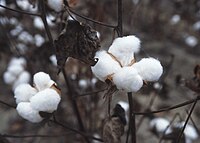
Photo from wikipedia
Cotton (Gossypium hirsutum L.) is a major fibre crop that is greatly affected by climatic factors, especially drought and high temperatures. Excessive temperature (above 30 °C) during the reproductive stage… Click to show full abstract
Cotton (Gossypium hirsutum L.) is a major fibre crop that is greatly affected by climatic factors, especially drought and high temperatures. Excessive temperature (above 30 °C) during the reproductive stage (flowering) negatively affects cotton yield potential. Four diverse cotton genotypes were evaluated in a greenhouse study at Rustenburg, North West province, South Africa to elicit information on heat tolerance using chlorophyll a fluorescence (ChlF) measurements. The ChlF measurements were made under laboratory conditions in an effort to develop a quick, reliable and inexpensive procedure capable of predicting heat stress on cotton. Tests consisted of measurements of maximum quantum yield (F v/F m) performed on intact leaves of cotton plants. Plants were subjected to two heat treatments, namely 30 °C and 40 °C for 6 hours, and measured with the M-PEA fluorometer. The maximum quantum yield (F v/F m) decreased significantly when plants were subjected to 40 °C as compared to the 30 °C treatment. This decrease in the maximum quantum yield indicates damage to the photosynthetic apparatus of the plants.
Journal Title: South African Journal of Plant and Soil
Year Published: 2020
Link to full text (if available)
Share on Social Media: Sign Up to like & get
recommendations!